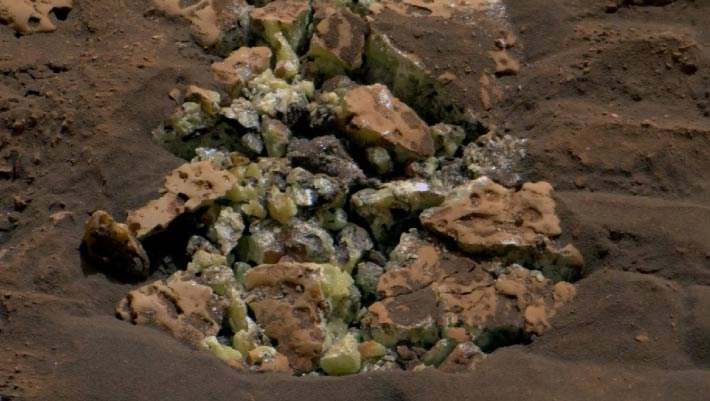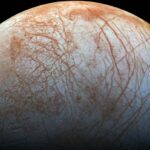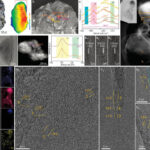Yellow crystals of elemental sulfur were revealed after NASA’s Curiosity rover happened to drive over a rock and crack it open on May 30, 2024, according to the Curiosity team.
While people associate sulfur with the odor from rotten eggs, elemental sulfur is odorless.
It forms in only a narrow range of conditions that scientists haven’t associated with the history of this location.
And Curiosity found a lot of it — an entire field of bright rocks that look similar to the one the rover crushed.
“Finding a field of stones made of pure sulfur is like finding an oasis in the desert,” said Curiosity’s project scientist Dr. Ashwin Vasavada, a researcher at NASA’s Jet Propulsion Laboratory.
“It shouldn’t be there, so now we have to explain it. Discovering strange and unexpected things is what makes planetary exploration so exciting.”
It’s one of several discoveries Curiosity has made while off-roading within Gediz Vallis channel, a groove that winds down part of the 5-km-tall (3-mile-tall) Mount Sharp, the base of which the rover has been ascending since 2014.
Spotted from space years before the rover’s launch, the channel is one of the primary reasons the science team wanted to visit this part of Mars.
They think that the channel was carved by flows of liquid water and debris that left a ridge of boulders and sediment extending 3.2 km (2 miles) down the mountainside below the channel.
The goal has been to develop a better understanding of how this landscape changed billions of years ago, and while recent clues have helped, there’s still much to learn from the dramatic landscape.
Since Curiosity’s arrival at the channel earlier this year, scientists have studied whether ancient floodwaters or landslides built up the large mounds of debris that rise up from the channel’s floor here.
The latest clues from the rover suggest both played a role: some piles were likely left by violent flows of water and debris, while others appear to be the result of more local landslides.
Those conclusions are based on rocks found in the debris mounds: whereas stones carried by water flows become rounded like river rocks, some of the debris mounds are riddled with more angular rocks that may have been deposited by dry avalanches.
Finally, water soaked into all the material that settled here.
Chemical reactions caused by the water bleached white ‘halo’ shapes into some of the rocks.
Erosion from wind and sand has revealed these halo shapes over time.
“This was not a quiet period on Mars,” said Dr. Becky Williams, a scientist with the Planetary Science Institute in Tucson, Arizona, and the deputy principal investigator of Curiosity’s Mast Camera.
“There was an exciting amount of activity here. We’re looking at multiple flows down the channel, including energetic floods and boulder-rich flows.”
_____
This article is a version of a press-release provided by NASA.




